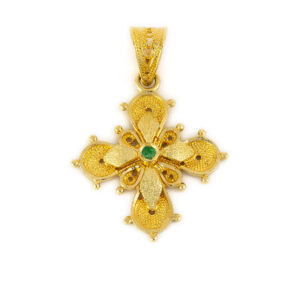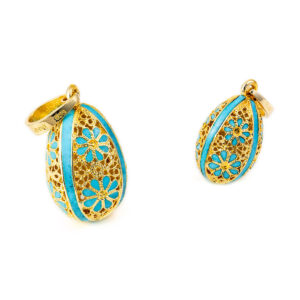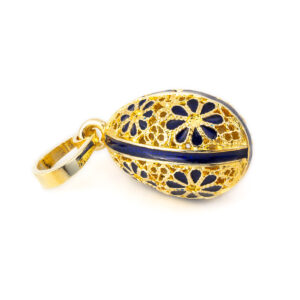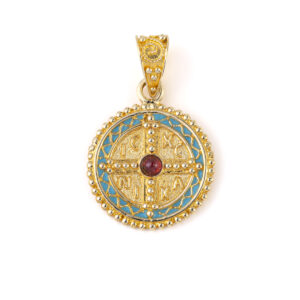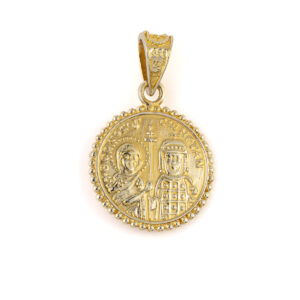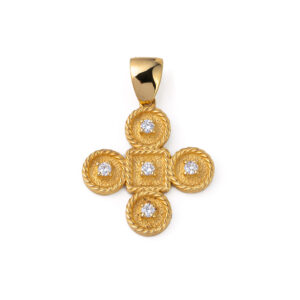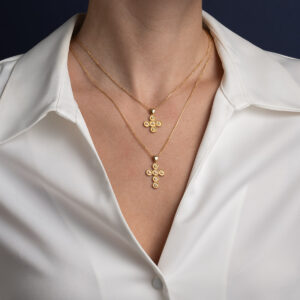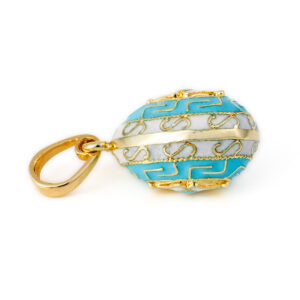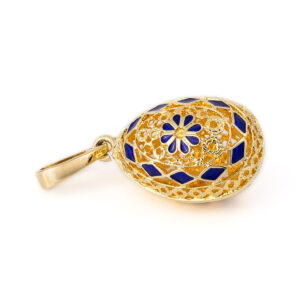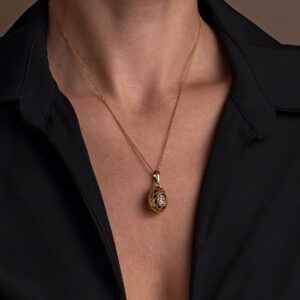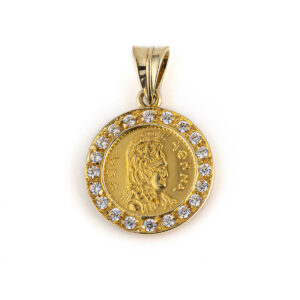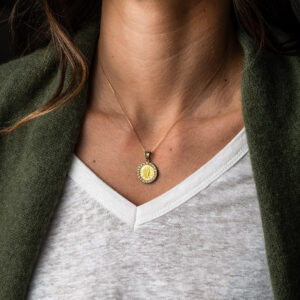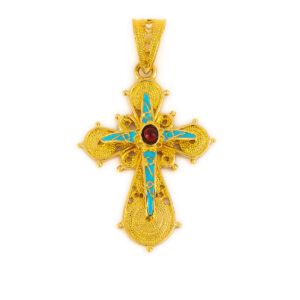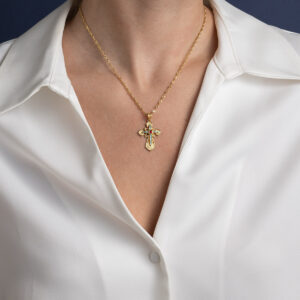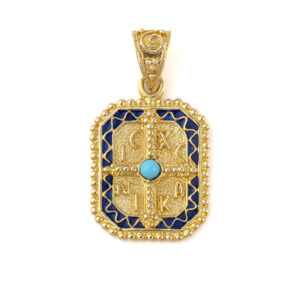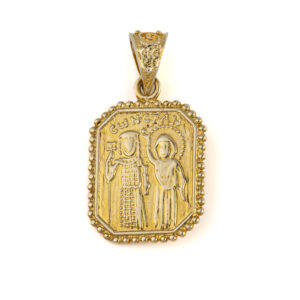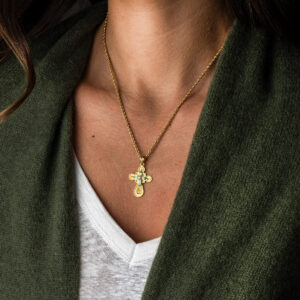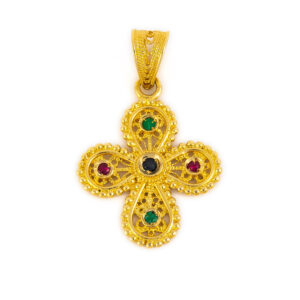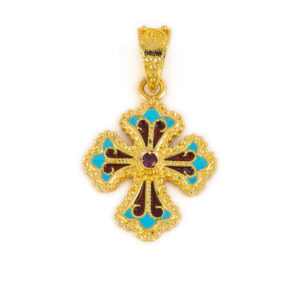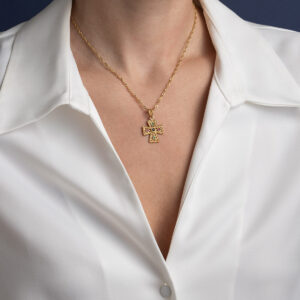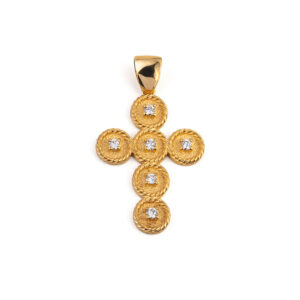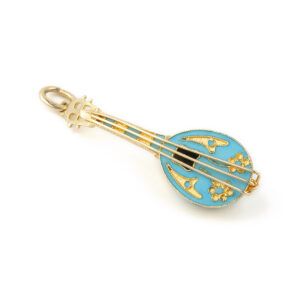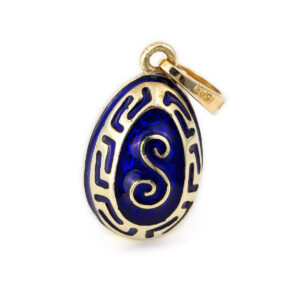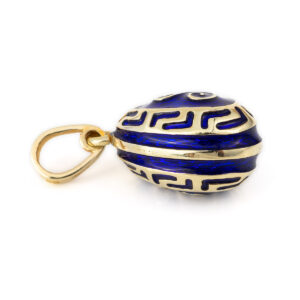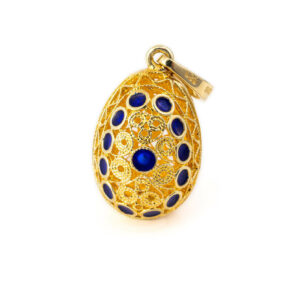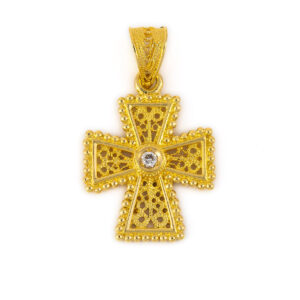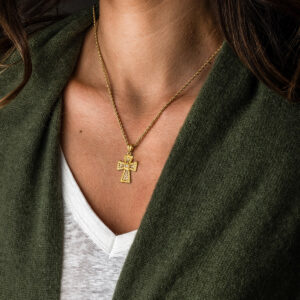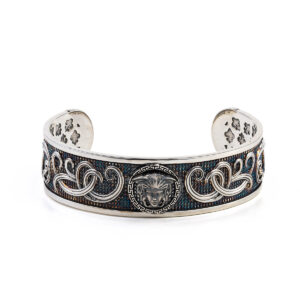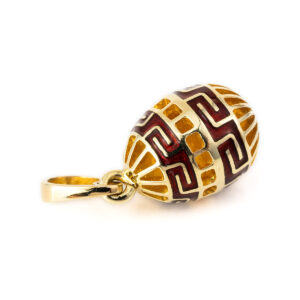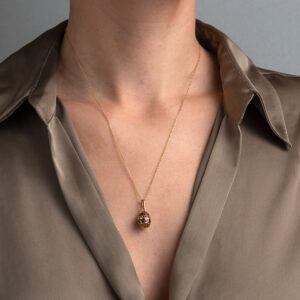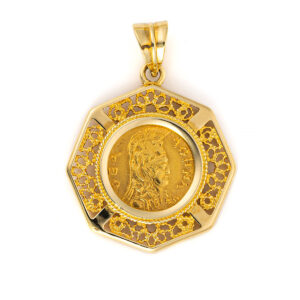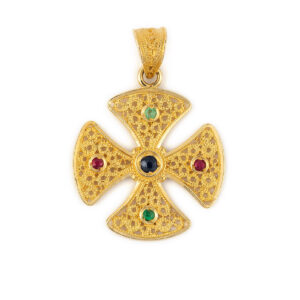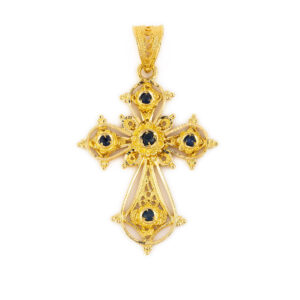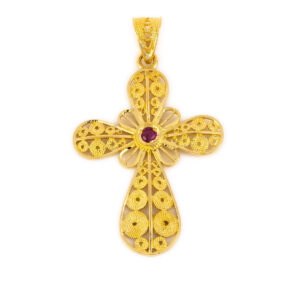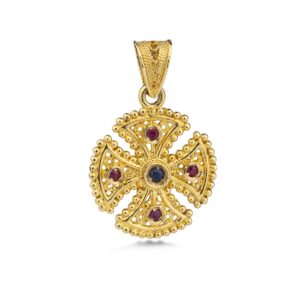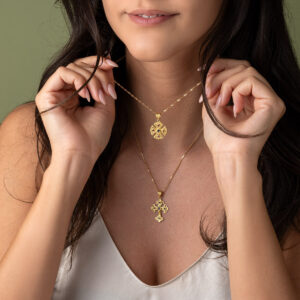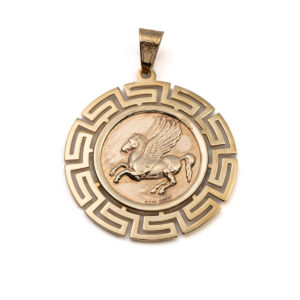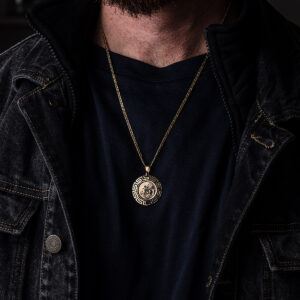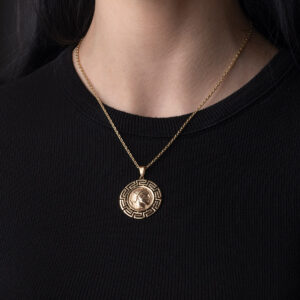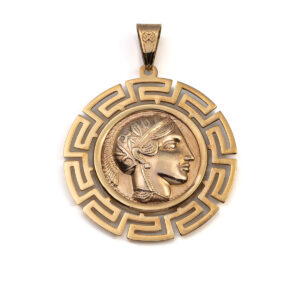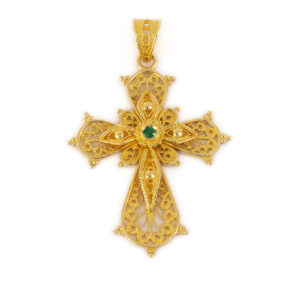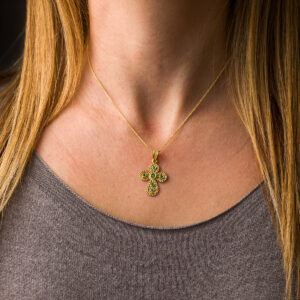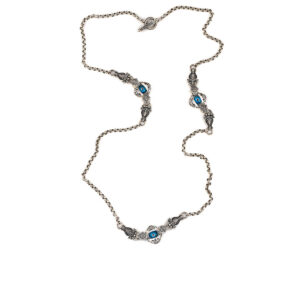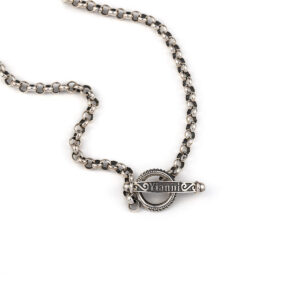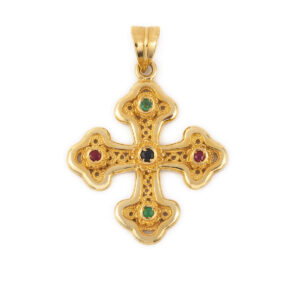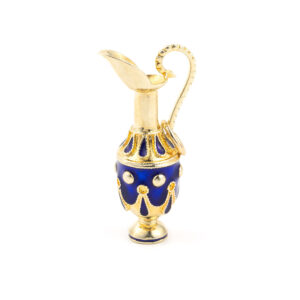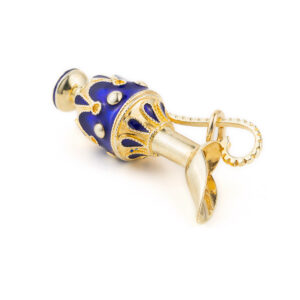18K Gold Byzantine Filigree Emerald Cross
742,00€Byzantine Cross embellished with a fine filigree, an emerald gemstone in the middle and granules of precious metal.
Handmade with great attention to detail. Inspired by Byzantine art.
Made in 18k gold
Filigree is a delicate kind of jewellery metalwork, made with tiny beads or twisted threads, or both in combination, soldered together or to the surface of an object of the same metal and arranged in artistic motifs. The art of filigree dates back to ancient history. The first of the found jewelry in this technique has been found in Mesopotamia and dates to thousands of years BC. In the ancient world and particularly in Asia Minor, this art grew at the highest level.
Explore Religious Collection
Filigree Egg Pendant with Flowers – 14k Gold and Turquoise Enamel
771,00€ – 1.199,00€The pendant is embellished with flowers in Faberge style.
Used as a charm or as a pendant.
Pick up a beautiful gift inspired by the majestic art of Fabergé!
Made in 14k gold and turquoise enamel.
The chain shown is our 14K Gold Chain (not included).
The rosette (rose) is a timeless jewel, symbol, and amulet. The origin of the term is the Greek word for rose – rodon (ρόδον). Its use began in the Mycenaean era and continues as far as the 2nd millennia BC. The Mycenaean Rosette is a motif that was widespread throughout Mesopotamia, Egypt, Greece, and other ancient civilizations. Rosette or Rodax was probably the most popular and favorite decorative element in the Mycenaean era, classical antiquity, and Byzantine times.
Fabergé egg is a jeweled egg created by the House of Fabergé, in St. Petersburg, Imperial Russia. Virtually all were manufactured under the supervision of Peter Carl Fabergé between 1885 and 1917,[citation needed] the most famous being the 50 “Imperial” eggs, 43 of which survive, made for the Russian Tsars Alexander III and Nicholas II as Easter gifts for their wives and mothers. The first Fabergé egg was crafted for Tsar Alexander III, who had decided to give his wife, Empress Maria Feodorovna, an Easter egg in 1885. Peter Carl Fabergé was a Russian jeweler best known for the famous Fabergé eggs made in the style of genuine Easter eggs, using precious metals and gemstones. He’s the founder of the famous jewelry legacy House of Fabergé.
As in all handmade items, there may be small differences in weight and dimensions, making them unique and precious.
Filigree Egg Pendant with Flowers – 14k Gold and Blue Enamel
771,00€The pendant is embellished with fine filigree and blue enamel in Faberge style.
Used as a charm or as a pendant.
Pick up a beautiful gift inspired by the majestic art of Fabergé!
Made in 14k yellow gold
Filigree is a delicate kind of jewelry metalwork, made with tiny beads or twisted threads, or both in combination, soldered together or to the surface of an object of the same metal and arranged in artistic motifs. The art of filigree dates back to ancient history. The first of the found jewelry in this technique has been found in Mesopotamia and dates to thousands of years BC. In the ancient world and particularly in Asia Minor, this art grew at the highest level.
Rosette The rosette (rose) is a timeless jewel, symbol, and amulet. The origin of the term is the Greek word for rose – rodon (ρόδον). Its use began in the Mycenaean era and continues as far as the 2nd millennia BC. The Mycenaean Rosette is a motif that was widespread throughout Mesopotamia, Egypt, Greece, and other ancient civilizations. Rosette or Rodax was probably the most popular and favorite decorative element in the Mycenaean era, classical antiquity, and Byzantine times.
Fabergé egg is a jeweled egg created by the House of Fabergé, in St. Petersburg, Imperial Russia. Virtually all were manufactured under the supervision of Peter Carl Fabergé between 1885 and 1917,[citation needed] the most famous being the 50 “Imperial” eggs, 43 of which survive, made for the Russian Tsars Alexander III and Nicholas II as Easter gifts for their wives and mothers. The first Fabergé egg was crafted for Tsar Alexander III, who had decided to give his wife, Empress Maria Feodorovna, an Easter egg in 1885. Peter Carl Fabergé was a Russian jeweller best known for the famous Fabergé eggs made in the style of genuine Easter eggs, using precious metals and gemstones. He’s the founder of the famous jewelry legacy House of Fabergé.
Constantinato Pendant with Enamel – 14K Gold
772,00€A handmade gold Constantinato pendant that depicts a cross on the one side and Saints Constantine and Helena on the other side.
A unique pendant that you can offer to your special ones as a protection gift or buy it for yourself.
Made of 14k gold.
Handmade in Greece
14K Gold Zircon Cross
782,00€Beautiful Cross Pendant made of 14K Solid Gold.
Handmade in Greece
Baptism crosses and baptism crucifixes are classic gifts for a child and their parents on the special occasion of a child’s baptism.
Explore Religious Collection
18K Gold Filigree Sapphire Cross
795,00€Byzantine Cross embellished with a fine filigree and a sapphire gemstone in the middle.
Handmade with great attention to detail. Inspired by Byzantine art.
Made in 18k gold
Filigree is a delicate kind of jewellery metalwork, made with tiny beads or twisted threads, or both in combination, soldered together or to the surface of an object of the same metal and arranged in artistic motifs. The art of filigree dates back to ancient history. The first of the found jewelry in this technique has been found in Mesopotamia and dates to thousands of years BC. In the ancient world and particularly in Asia Minor, this art grew at the highest level.
Meander Egg Pendant with Spear Motif – 14k Gold and Enamel
814,00€The pendant is embellished with a Meander design and spear motif in Faberge style.
Used as a charm or as a pendant.
Pick up a beautiful gift inspired by the majestic art of Fabergé!
Made in 14k yellow gold and turquoise and white enamel
Fabergé egg is a jeweled egg created by the House of Fabergé, in St. Petersburg, Imperial Russia. Virtually all were manufactured under the supervision of Peter Carl Fabergé between 1885 and 1917,[citation needed] the most famous being the 50 “Imperial” eggs, 43 of which survive, made for the Russian Tsars Alexander III and Nicholas II as Easter gifts for their wives and mothers. The first Fabergé egg was crafted for Tsar Alexander III, who had decided to give his wife, Empress Maria Feodorovna, an Easter egg in 1885. Peter Carl Fabergé was a Russian jeweler best known for the famous Fabergé eggs made in the style of genuine Easter eggs, using precious metals and gemstones. He’s the founder of the famous jewelry legacy House of Fabergé.
Meander or Meandros design, one of the most historic symbols of the Greek World, also called Greek Key and symbolizes long life and eternity.
As in all handmade items, there may be small differences in weight and dimensions, making them unique and precious.
14k Gold and Blue Enamel Filigree Egg Pendant
814,00€The pendant is embellished with fine filigree and blue enamel in Faberge style.
Used as a charm or as a pendant.
Pick up a beautiful gift inspired by the majestic art of Fabergé!
Made in 14k yellow gold.
Handmade in Greece.
History
Filigree is a delicate kind of jewelry metalwork, made with tiny beads or twisted threads, or both in combination, soldered together or to the surface of an object of the same metal and arranged in artistic motifs. The art of filigree dates back to ancient history. The first of the found jewelry in this technique has been found in Mesopotamia and dates to thousands of years BC. In the ancient world and particularly in Asia Minor, this art grew at the highest level.
Rosette The rosette (rose) is a timeless jewel, symbol, and amulet. The origin of the term is the Greek word for rose – rodon (ρόδον). Its use began in the Mycenaean era and continues as far as the 2nd millennia BC. The Mycenaean Rosette is a motif that was widespread throughout Mesopotamia, Egypt, Greece, and other ancient civilizations. Rosette or Rodax was probably the most popular and favorite decorative element in the Mycenaean era, classical antiquity, and Byzantine times.
Fabergé egg is a jeweled egg created by the House of Fabergé, in St. Petersburg, Imperial Russia. Virtually all were manufactured under the supervision of Peter Carl Fabergé between 1885 and 1917,[citation needed] the most famous being the 50 “Imperial” eggs, 43 of which survive, made for the Russian Tsars Alexander III and Nicholas II as Easter gifts for their wives and mothers. The first Fabergé egg was crafted for Tsar Alexander III, who had decided to give his wife, the Empress Maria Feodorovna, an Easter egg in 1885. Peter Carl Fabergé was a Russian jeweller best known for the famous Fabergé eggs made in the style of genuine Easter eggs, using precious metals and gemstones. He’s the founder of the famous jewelry legacy House of Fabergé.
Goddess Athena and Owl Pendant with Crystals – 14K Solid Gold
835,00€This coin illustrates the portrait of Goddess Athena on the one side and the wisdom owl on the other.
Α beautiful and timeless coin pendant.
Made of 14k gold with crystals.
The chain shown is our 14K Gold Box Chain in Length 50cm (not included).
Goddess Athena and Owl – Athenian silver tetradrachm.
Dracma was the currency used in Greece during several periods in its history. The tetradrachm was an Ancient Greek silver coin equivalent to fourdrachmae in Athens it replaced the earlier “heraldic” type of didrachms and it was in wide circulation from ca. 510 to ca. 38 BC. This coin belongs to the so-called “new style Athenian coins” minted between 166 and 64 B.C. and is considered one of the most popular ancient Greek coins which illustrate the portrait of Goddess Athena on the one side and the wisdom owl on the other. Athena is an ancient Greek goddess associated with wisdom, handicraft, and warfare. Athena was regarded as the patron and protectress of various cities across Greece, particularly the city of Athens, from which she most likely received her name. She’s usually shown in art wearing a helmet and holding a spear. Her major symbols include owls, olive trees, and snakes. Her temples were located atop the fortified Acropolis in the central part of the city. The Parthenon on the Athenian Acropolis is dedicated to her, along with numerous other temples and monuments. Her main festival in Athens was the Panathenaia, which was celebrated in midsummer and was the most important festival on the Athenian calendar. In the classical Olympian pantheon, Athena was regarded as the favorite daughter of Zeus. The owl traditionally accompanies Athena. Because of such association, the owl has been used as a symbol of knowledge and wisdom. The inscriptions contain the city’s “national” appellation (“ΑΘΕ», i.e. “of the Athenians”). As in all handmade items, there may be small differences in weight and dimensions and this is what makes them unique and precious.
18K Gold Filigree Cross with turquoise and red enamel
848,00€Byzantine Cross embellished with fine filigree and double enamel
Handmade with great attention to detail. Inspired by Byzantine art.
Made in 18k gold.
The chain shown in the second photo is our Twisted Chain 14k Gold (not included)
Explore Religious Collection
Filigree is a delicate kind of jewellery metalwork, made with tiny beads or twisted threads, or both in combination, soldered together or to the surface of an object of the same metal and arranged in artistic motifs. The art of filigree dates back to ancient history. The first of the found jewelry in this technique has been found in Mesopotamia and dates to thousands of years BC. In the ancient world and particularly in Asia Minor, this art grew at the highest level.
Egg Pendant with Rosette Flowers – 14k Gold
856,00€The pendant is embellished with rosette flowers in Faberge style.
Used as a charm or as a pendant.
Pick up a beautiful gift inspired by the majestic art of Fabergé!
Made in 14k gold and turquoise enamel.
Fabergé egg is a jeweled egg created by the House of Fabergé, in St. Petersburg, Imperial Russia. Virtually all were manufactured under the supervision of Peter Carl Fabergé between 1885 and 1917,[citation needed] the most famous being the 50 “Imperial” eggs, 43 of which survive, made for the Russian Tsars Alexander III and Nicholas II as Easter gifts for their wives and mothers. The first Fabergé egg was crafted for Tsar Alexander III, who had decided to give his wife, Empress Maria Feodorovna, an Easter egg in 1885. Peter Carl Fabergé was a Russian jeweler best known for the famous Fabergé eggs made in the style of genuine Easter eggs, using precious metals and gemstones. He’s the founder of the famous jewelry legacy House of Fabergé.
The rosette (rose) is a timeless jewel, symbol, and amulet. The origin of the term is the Greek word for rose – rodon (ρόδον). Its use began in the Mycenaean era and continues as far as the 2nd millennia BC. The Mycenaean Rosette is a motif that was widespread throughout Mesopotamia, Egypt, Greece, and other ancient civilizations. Rosette or Rodax was probably the most popular and favorite decorative element in the Mycenaean era, classical antiquity, and Byzantine times.
As in all handmade items, there may be small differences in weight and dimensions, making them unique and precious.
Constantinato Rectangle Pendant with Turquoise – Gold 14K
856,00€A handmade gold Constantinato pendant that depicts a cross on the one side and Saints Constantine and Helena on the other side.
A unique pendant that you can offer to your special ones as a protection gift or buy it for yourself.
Made of 14k gold.
Handmade in Greece
18K Gold Filigree Cross with Pearl
873,00€ – 1.404,00€The cross is embellished with a fine filigree, turquoise enamel and pearl.
Inspired by Byzantine art.
Made in 18k gold
Handmade item.
The chain shown is our 14K Gold Rope Chain (not included).
Filigree is a delicate kind of jewellery metalwork, made with tiny beads or twisted threads, or both in combination, soldered together or to the surface of an object of the same metal and arranged in artistic motifs. The art of filigree dates back to ancient history. The first of the found jewelry in this technique has been found in Mesopotamia and dates to thousands of years BC. In the ancient world and particularly in Asia Minor, this art grew at the highest level.
18K Gold Filigree Cross with rubies, emeralds and sapphires
874,00€Byzantine Cross decorated with rubies, emeralds and sapphires, granules of precious metal and fine filigree.
Inspired by Byzantine art.
Made in 18k gold
Handmade item
The chain shown is our 14K Gold Rope Chain (not included).
Granulation (from Latin: granum = “grain”) is a jewellery technique whereby a surface of a jewel is covered with small spheres or granules of precious metal. The technique is thought to have its origins in Mesopotamia about 5,000 years ago.
Filigree is a delicate kind of jewellery metalwork, made with tiny beads or twisted threads, or both in combination, soldered together or to the surface of an object of the same metal and arranged in artistic motifs. The art of filigree dates back to ancient history. The first of the found jewelry in this technique has been found in Mesopotamia and dates to thousands of years BC. In the ancient world and particularly in Asia Minor, this art grew at the highest level.
18K Gold Byzantine Filigree Cross with rubies emeralds and sapphires
875,00€Byzantine Cross decorated with rubies, emeralds and sapphires, granules of precious metal and fine filigree.
Inspired by Byzantine art.
Made in 18k gold
Handmade item
The chain shown is our 14K Gold Chain (not included).
Granulation (from Latin: granum = “grain”) is a jewellery technique whereby a surface of a jewel is covered with small spheres or granules of precious metal. The technique is thought to have its origins in Mesopotamia about 5,000 years ago.
Filigree is a delicate kind of jewellery metalwork, made with tiny beads or twisted threads, or both in combination, soldered together or to the surface of an object of the same metal and arranged in artistic motifs. The art of filigree dates back to ancient history. The first of the found jewelry in this technique has been found in Mesopotamia and dates to thousands of years BC. In the ancient world and particularly in Asia Minor, this art grew at the highest level.
18K Gold Byzantine Filigree Cross with Turquoise Enamel
875,00€Byzantine Cross embellished with a fine filigree, turquoise & red enamel and granules of precious metal.
The back side of the cross has no decoration.
Handmade with great attention to detail. Inspired by Byzantine art.
Made in 18k gold
Filigree is a delicate kind of jewellery metalwork, made with tiny beads or twisted threads, or both in combination, soldered together or to the surface of an object of the same metal and arranged in artistic motifs. The art of filigree dates back to ancient history. The first of the found jewelry in this technique has been found in Mesopotamia and dates to thousands of years BC. In the ancient world and particularly in Asia Minor, this art grew at the highest level.
Granulation (from Latin: granum = “grain”) is a jewellery technique whereby a surface of a jewel is covered with small spheres or granules of precious metal. The technique is thought to have its origins in Mesopotamia about 5,000 years ago.
As in all handmade items there may be small differences in weight and dimensions and this is what makes them unique and precious.
18K Gold Filigree Cross with Stones
901,00€Byzantine Cross decorated with rubies or emeralds or sapphires, granules of precious metal and fine filigree. Choose among emeralds, rubies, sapphires or multi-precious stones.
Handmade with great attention to detail. Inspired by Byzantine art.
Made in 18k gold
Filigree is a delicate kind of jewellery metalwork, made with tiny beads or twisted threads, or both in combination, soldered together or to the surface of an object of the same metal and arranged in artistic motifs. The art of filigree dates back to ancient history. The first of the found jewelry in this technique has been found in Mesopotamia and dates to thousands of years BC. In the ancient world and particularly in Asia Minor, this art grew at the highest level.
Granulation (from Latin: granum = “grain”) is a jewellery technique whereby a surface of a jewel is covered with small spheres or granules of precious metal. The technique is thought to have its origins in Mesopotamia about 5,000 years ago.
14K Gold Cross with Zircon
912,00€Beautiful Cross Pendant made of 14K Solid Gold.
Handmade in Greece
Baptism crosses and baptism crucifixes are classic gifts for a child and their parents on the special occasion of a child’s baptism.
Explore Religious Collection
14k Yellow Gold Greek Bouzouki Charm with Turquoise Enamel
920,00€Greek Bouzouki Charm with turquoise enamel decorated with rosette motifs.
Made in 14k yellow gold.
Used as a charm or as a pendant.
Handmade in Greece.
Design inspired by the Greek tradition.
Explore Heritage Collection
History
The Greek bouzouki is a plucked musical instrument of the lute family, called the thabouras or tambouras family. The tambouras existed in ancient Greece as the pandura, and can be found in various sizes and shapes. The bouzouki and the baglamas are the direct descendants. The bouzouki arrived in Greece following the 1919–1922 war in Asia Minor and the subsequent population exchange between Greece and Turkey. The early bouzoukia mostly had three courses. At the end of the 1950s, four-course (tetrachordo) bouzoukia started to gain popularity. The four-course bouzouki was made popular by Manolis Chiotis. Manolis Chiotis was a Greek rebetiko and laiko composer, singer, and bouzouki player. He is considered one of the greatest bouzouki soloists of all time.
Meander Egg Pendant – 14k Gold and Blue Enamel
920,00€The pendant is embellished with Meander design.
Used as a charm or as a pendant.
Pick up a beautiful gift inspired by the majestic art of Fabergé!
Made in 14k yellow gold and blue enamel
Fabergé egg is a jeweled egg created by the House of Fabergé, in St. Petersburg, Imperial Russia. Virtually all were manufactured under the supervision of Peter Carl Fabergé between 1885 and 1917,[citation needed] the most famous being the 50 “Imperial” eggs, 43 of which survive, made for the Russian Tsars Alexander III and Nicholas II as Easter gifts for their wives and mothers. The first Fabergé egg was crafted for Tsar Alexander III, who had decided to give his wife, the Empress Maria Feodorovna, an Easter egg in 1885. Peter Carl Fabergé was a Russian jeweller best known for the famous Fabergé eggs made in the style of genuine Easter eggs, using precious metals and gemstones. He’s the founder of the famous jewelry legacy House of Fabergé.
Meander or Meandros design, one of the most historic symbols of the Greek World, also called Greek Key and symbolizes long life and eternity.
As in all handmade items there may be small differences in weight and dimensions and this is what makes them unique and precious.
Filigree Egg Pendant – 14k Gold with Blue Enamel
920,00€The pendant is embellished with fine filigree and blue enamel in Faberge style.
Used as a charm or as a pendant.
Pick up a beautiful gift inspired by the majestic art of Fabergé!
Made in 14k yellow gold
Filigree is a delicate kind of jewelry metalwork, made with tiny beads or twisted threads, or both in combination, soldered together or to the surface of an object of the same metal and arranged in artistic motifs. The art of filigree dates back to ancient history. The first of the found jewelry in this technique has been found in Mesopotamia and dates to thousands of years BC. In the ancient world and particularly in Asia Minor, this art grew at the highest level.
Fabergé egg is a jeweled egg created by the House of Fabergé, in St. Petersburg, Imperial Russia. Virtually all were manufactured under the supervision of Peter Carl Fabergé between 1885 and 1917,[citation needed] the most famous being the 50 “Imperial” eggs, 43 of which survive, made for the Russian Tsars Alexander III and Nicholas II as Easter gifts for their wives and mothers. The first Fabergé egg was crafted for Tsar Alexander III, who had decided to give his wife, Empress Maria Feodorovna, an Easter egg in 1885. Peter Carl Fabergé was a Russian jeweler best known for the famous Fabergé eggs made in the style of genuine Easter eggs, using precious metals and gemstones. He’s the founder of the famous jewelry legacy House of Fabergé.
As in all handmade items, there may be small differences in weight and dimensions, making them unique and precious.
Byzantine Mother of Pearl Bracelet – Sterling Silver
Made of 925⁰ sterling silver
Handmade in Greece.
Silver creations of Yianni Jewelry, created by Garbis Khacherian, a silversmith trader since 1987.
Explore Yianni Jewellery
18K Gold Byzantine Cross with Swarovski
928,00€Byzantine Cross embellished with a fine filigree and great attention to detail. The decoration of this cross shows the influence of the Byzantine art.
Made in 18k gold.
Handmade item
The chain shown is our 14K Gold Rope Chain (not included).
Filigree is a delicate kind of jewellery metalwork, made with tiny beads or twisted threads, or both in combination, soldered together or to the surface of an object of the same metal and arranged in artistic motifs. The art of filigree dates back to ancient history. The first of the found jewelry in this technique has been found in Mesopotamia and dates to thousands of years BC. In the ancient world and particularly in Asia Minor, this art grew at the highest level.
Medusa Bracelet Handmade Cuff Silver 925
Made of 925⁰ sterling silver
Handmade in Greece.
Silver creations of Yianni Jewelry, created by Garbis Khacherian, a silversmith trader since 1987.
Explore Yianni Jewellery
History
Medusa, in Greek mythology, the most famous of the monster figures known as Gorgons, is generally described as a winged female with living venomous snakes in place of hair; unlike the Gorgons, she was sometimes represented as very beautiful. According to Hesiod and Aeschylus, she lived and died on an island named Sarpedon, somewhere near Cisthene. Medusa was beheaded by the hero Perseus, who thereafter used her head, which retained its ability to turn onlookers to stone, as a weapon until he gave it to the goddess Athena to place on her shield. according to another account; Perseus buried it in the marketplace of Argos. The Labyrinth in ancient Greek was an elaborate, confusing structure designed and built by the legendary artificer Daedalus for King Minos of Crete at Knossos. Its function was to hold the Minotaur. the Minotaur is a mythical creature portrayed in Classical times with the head of a bull and the body of a man. The Minotaur was eventually killed by the Athenian hero Theseus.
Meander Egg Pendant – 14k Gold and Red Enamel
964,00€The pendant is embellished with a Meander design.
Used as a charm or as a pendant.
Pick up a beautiful gift inspired by the majestic art of Fabergé!
Made in 14k yellow gold and red enamel.
The chain shown is our Cable Chain in 14K Gold (not included).
Meander or Meandros design is a decorative border constructed from a continuous line, shaped into a repeated motif. Such a design is also called the Greek fret or Greek key design, although these are modern designations. On the one hand, the name “meander” recalls the twisting and turning path of the Meander River in Asia Minor, and on the other hand, as Karl Kerenyi pointed out, “the meander is the figure of a labyrinth in linear form” the meaning is that there is no beginning and no end in some cases so it becomes the symbol of long life and eternity.
Fabergé egg is a jeweled egg created by the House of Fabergé, in St. Petersburg, Imperial Russia. Virtually all were manufactured under the supervision of Peter Carl Fabergé between 1885 and 1917,[citation needed] the most famous being the 50 “Imperial” eggs, 43 of which survive, made for the Russian Tsars Alexander III and Nicholas II as Easter gifts for their wives and mothers. The first Fabergé egg was crafted for Tsar Alexander III, who had decided to give his wife, Empress Maria Feodorovna, an Easter egg in 1885. Peter Carl Fabergé was a Russian jeweler best known for the famous Fabergé eggs made in the style of genuine Easter eggs, using precious metals and gemstones. He’s the founder of the famous jewelry legacy House of Fabergé.
As in all handmade items, there may be small differences in weight and dimensions, making them unique and precious.
Goddess Athena Coin Pendant – Gold 14K
984,00€Α beautiful and timeless Coin Pendant with Goddess Athena
Made in 14k gold.
The chain shown is our 14K Gold Spiga Chain (not included)
Goddess Athena and Owl – Athenian silver tetradrachm
Dracma was the currency used in Greece during several periods in its history.
The tetradrachm was an Ancient Greek silver coin equivalent to fourdrachmae in Athens it replaced the earlier “heraldic” type of didrachms and it was in wide circulation from ca. 510 to ca. 38 BC.
This coin belongs to the so-called “new style Athenian coins” minted between 166 and 64 B.C. and is considered one of the most popular ancient Greek coins which illustrate the portrait of Goddess Athena on the one side and the wisdom owl on the other. Athena is an ancient Greek goddess associated with wisdom, handicraft, and warfare.
Athena was regarded as the patron and protectress of various cities across Greece, particularly the city of Athens, from which she most likely received her name. She’s usually shown in art wearing a helmet and holding a spear. Her major symbols include owls, olive trees, and snakes. Her temples were located atop the fortified Acropolis in the central part of the city. The Parthenon on the Athenian Acropolis is dedicated to her, along with numerous other temples and monuments. Her main festival in Athens was the Panathenaia, which was celebrated in midsummer and was the most important festival on the Athenian calendar.
In the classical Olympian pantheon, Athena was regarded as the favorite daughter of Zeus. The owl traditionally accompanies Athena. Because of such association, the owl has been used as a symbol of knowledge and wisdom. The inscriptions contain the city’s “national” appellation (“ΑΘΕ», i.e. “of the Athenians”).
Byzantine Cross in 18K Gold with rubies emeralds and sapphires
1.007,00€Byzantine Cross with rubies, emeralds and sapphires
Inspired by Byzantine art.
Made in 18k yellow gold
Handmade item.
The chain shown is our 14K Gold Rope Chain (not included).
As in all handmade items, there may be small differences in weight and dimensions and this is what makes them unique and precious.
18K Gold Cross with Sapphire
1.007,00€Byzantine Cross embellished with a fine filigree and gemstones. Choose among emeralds, rubies, sapphires or multi-stones.
Handmade with great attention to detail. Inspired by Byzantine art.
Made in 18k gold.
The chain shown is our 14K Gold Spiga Chain (not included)
Filigree is a delicate kind of jewellery metalwork, made with tiny beads or twisted threads, or both in combination, soldered together or to the surface of an object of the same metal and arranged in artistic motifs. The art of filigree dates back to ancient history. The first of the found jewelry in this technique has been found in Mesopotamia and dates to thousands of years BC. In the ancient world and particularly in Asia Minor, this art grew at the highest level.
Byzantine Filigree Ruby Cross in 18K Gold
1.007,00€Byzantine Cross embellished with fine filigree and a flower in the center which is decorated with a ruby
Handmade with great attention to detail. Inspired by Byzantine art.
Made in 18k gold
Filigree is a delicate kind of jewellery metalwork, made with tiny beads or twisted threads, or both in combination, soldered together or to the surface of an object of the same metal and arranged in artistic motifs. The art of filigree dates back to ancient history. The first of the found jewelry in this technique has been found in Mesopotamia and dates to thousands of years BC. In the ancient world and particularly in Asia Minor, this art grew at the highest level.
18k Gold Filigree Byzantine Cross With Ruby and Sapphire
1.098,00€Discover the beauty of timeless craftsmanship with this stunning 18k gold Byzantine filigree cross pendant. This handmade piece draws inspiration from the intricate patterns of traditional Byzantine jewelry. The front showcases delicate filigree detailing, while the reverse is polished and unadorned for a classic finish.
Perfect as a religious gift or statement pendant, this handcrafted gold cross celebrates both faith and art. Ideal for those searching for Byzantine gold jewelry, handmade gold crosses, or 18k religious pendants.
Explore Religious Collection
Pegasus Coin Pendant Meander Bezel 14K Gold
1.114,00€A pendant depicting the mythological winged horse Pegasus.
Made of 14k gold.
Handmade in Greece with the finest attention to detail.
The chain shown in the second picture is our Rollo Chain – 14K Gold (not included).
Explore Coins Collection
History
Pegasus is a mythical winged divine stallion, and one of the most recognized creatures in Greek mythology. Usually depicted as pure white, Pegasus is a child of the Olympian god Poseidon. Pegasus was caught by the Greek hero Bellerophon, near the fountain Peirene, with the help of Athena and Poseidon. Pegasus allowed Bellerophon to ride him in order to defeat the monstrous Chimera, which led to many other exploits. Bellerophon later fell from the winged horse’s back while trying to reach Mount Olympus. Afterwards, Zeus transformed Pegasus into the eponymous constellation.
Alexander the Great 14K Gold Coin Pendant Meander Bezel
1.115,00€Α beautiful and timeless Coin Pendant inspired by the ancient Greek tetradrachm coin of Alexander the Great.
Made of 14k gold.
The chain shown in the second picture is our Rollo Chain – 14K Gold (not included).
Explore Coins Collection
History
This Ancient Greek coin represents Alexander the Great on one side, and the Lysimachou on the other. The inscription reads Lysimachou in greek fonts. Alexander the Great the King of Macedonia is considered one of the most important forms of world history. Lysimachus was a Macedonian officer and diadochus of Alexander the Great, who became a basileus in 306 BC, ruling Thrace, Asia Minor and Macedon.
Athena and the Owl of Wisdom Coin Pendant – 14k Gold
1.115,00€One of the most popular ancient Greek coins illustrates Athena’s head on one side and the wisdom owl on the other.
Made of 14k gold.
Handmade in Greece.
The chain shown in the second picture is our Rollo Chain – 14K Gold (not included).
Explore Coins Collection
Goddess Athena and Owl – Athenian silver tetradrachm
Dracma was the currency used in Greece during several periods in its history. The tetradrachm was an Ancient Greek silver coin equivalent to fourdrachmae in Athens it replaced the earlier “heraldic” type of didrachms and it was in wide circulation from ca. 510 to ca. 38 BC. This coin belongs to the so-called “new style Athenian coins” minted between 166 and 64 B.C. and is considered one of the most popular ancient Greek coins which illustrate the portrait of Goddess Athena on the one side and the wisdom owl on the other. Athena is an ancient Greek goddess associated with wisdom, handicraft, and warfare. Athena was regarded as the patron and protectress of various cities across Greece, particularly the city of Athens, from which she most likely received her name. She’s usually shown in art wearing a helmet and holding a spear. Her major symbols include owls, olive trees, and snakes. Her temples were located atop the fortified Acropolis in the central part of the city. The Parthenon on the Athenian Acropolis is dedicated to her, along with numerous other temples and monuments. Her main festival in Athens was the Panathenaia, which was celebrated in midsummer and was the most important festival on the Athenian calendar. In the classical Olympian pantheon, Athena was regarded as the favorite daughter of Zeus. The owl traditionally accompanies Athena. Because of such association, the owl has been used as a symbol of knowledge and wisdom. The inscriptions contain the city’s “national” appellation (“ΑΘΕ», i.e. “of the Athenians”).
18K Gold Filigree Emerald Cross
1.166,00€Byzantine Cross embellished with a fine filigree, an emerald gemstone in the middle and granules of precious metal.
Handmade with great attention to detail. Inspired by Byzantine art.
Made in 18k gold.
Explore Religious Collection
Filigree is a delicate kind of jewellery metalwork, made with tiny beads or twisted threads, or both in combination, soldered together or to the surface of an object of the same metal and arranged in artistic motifs. The art of filigree dates back to ancient history. The first of the found jewelry in this technique has been found in Mesopotamia and dates to thousands of years BC. In the ancient world and particularly in Asia Minor, this art grew at the highest level.
Granulation (from Latin: granum = “grain”) is a jewellery technique whereby a surface of a jewel is covered with small spheres or granules of precious metal. The technique is thought to have its origins in Mesopotamia about 5,000 years ago.
18K Gold Filigree Cross with Emeralds
1.219,00€Byzantine Cross embellished with a fine filigree and gemstones. Choose among emeralds, rubies, sapphires or multi-precious stones.
Handmade with great attention to detail. Inspired by Byzantine art.
Made in 18k solid gold.
The chain shown is our 14K Gold Spiga Chain (not included)
Filigree is a delicate kind of jewellery metalwork, made with tiny beads or twisted threads, or both in combination, soldered together or to the surface of an object of the same metal and arranged in artistic motifs. The art of filigree dates back to ancient history. The first of the found jewelry in this technique has been found in Mesopotamia and dates to thousands of years BC. In the ancient world and particularly in Asia Minor, this art grew at the highest level.
Evil Eye Necklace Sterling Silver – Yianni Jewelry
Made in 925° sterling silver.
Handmade item.
These silver creations of Yianni Jewelry, created by Garbis Khacherian, a silversmith trader since 1987.
18k Gold Byzantine Cross with multi precious stones
1.484,00€Byzantine Cross with multi-precious stones, rubies emeralds and sapphires.
Inspired by Byzantine art.
Made in 18k yellow gold
Handmade item As in all handmade items there may be small differences in weight and dimensions and this is what makes them unique and precious.
14k Gold Pendant Amphora with Blue enamel
1.648,00€Ancient Greek Amphora Pendant with blue enamel.
Design inspired by the ancient Greek history.
Made in 14k yellow gold
Also available with turquoise or green enamel
Handmade item
Amphora is a Greco – Roman word developed in ancient Greek during the Bronze Age. An amphora is a type of container of a characteristic shape and size. Amphorae were used for the transport and storage of various products, both liquid and dry, but mostly for wine. They are most often ceramic. the amphorae used in Ancient Greek vase painting. (source wikipedia)

